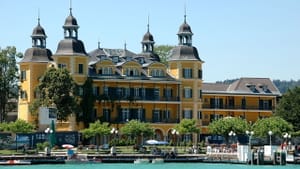Stay in the Loop
BSR publishes on a weekly schedule, with an email newsletter every Wednesday and Thursday morning. There’s no paywall, and subscribing is always free.
Romance with a touch of class
The Philadelphia Orchestra’s final Vienna concert (second review)

The last concert of the Philadelphia Orchestra’s series honoring Vienna’s contributions to music consisted of three works from the German and Austrian romantic repertoire with the kind of great performances that become reference points for interpretive clarity.
Unlike Eugene Ormandy’s naturally successful florid inclinations, Yannick Nézet-Séguin and the orchestra played the music as given in the score. They were helped along in the Schumann concerto by Leif Ove Andsnes’s expansive, held-back, and technically precise rendering of one of the most coherent and inspired compositions in the piano repertoire. This was romantic music that conveyed strong emotions within the structure of classical precision and tonal balance.
E pluribus unum
Webern’s Im Sommerwind, conceived shortly before the composer’s encounters with Arnold Schoenberg’s serialism, is transitional between romanticism and modernism. It is usually portrayed historically as a post-romantic tone poem based on Bruno Wille's idyllic poem evoking the wonders of nature as a metaphysical yet sensual being. It is also a carefully constructed synthesis of Romantic melodic and harmonic elements with Webern’s minimalist musical economy and muted angst.
Moreover, the piece has a gold-leaf essence reminiscent of the artist Gustav Klimt and a soft emergent quality akin to the work of Paul Klee. Webern’s genius is clear in the seamless way he integrated Renaissance contrapuntal forms with later harmonic structures — and he was able to navigate between sparse orchestration and the lush sonorities of Brahms, Richard Strauss, and Wagner. The result is a finely woven fabric of sound that tells a story of communion with nature.
The orchestra followed Nézet-Séguin closely through the piece’s nuances. They sounded lush and rich during the high romantic passages, and delicate and lucid during the minimalist sections, the latter typified by David Kim’s exquisite pianissimo violin solo. Nézet-Séguin, comfortable with the transitional aspects of the music, deftly negotiated its complexities, stressing the unity within the diversity of forms.
Generating electricity with digital precision
Leif Ove Andsnes is well on his way to becoming one of the great concert pianists of the New Millennium. He achieved critical acclaim with his recording of the Grieg and Schumann piano concertos, and he continues to deliver exciting performances that combine grand expression with high fidelity to the score and impeccable technique. In some ways, he is a product of the age of digital recording, in which every least little sound is caught; this challenges the artist to maintain metronomic accuracy while communicating spontaneity. (By comparison, warm and fuzzy vinyl recordings allowed musicians to get away with some of their aberrations.) In this live performance, Andsnes’s combination of precision and expressivity generated real electricity, inviting comparison with the very best of his peers and predecessors.
Schumann’s Piano Concerto (the only one he composed, despite being an accomplished pianist) has served as a model for other composers. It is rich in ideas and emotions while coherent and parsimonious. It also fulfilled Schumann’s self-acknowledged aim of creating balance and interaction between the piano and the orchestra. The exchange between the oboe and the piano in the first movement is well known, but the entire score puts the soloist and orchestra on an equal dialogical plane. This equality was further achieved here by virtue of the rich sound of both orchestra and soloist, as well as the professionalism of Andsnes and Nézet-Séguin working in tandem. One of the things that made this concert such a rare pleasure was that all the musicians seemed to be carefully attuned to one another as a highly coordinated ensemble.
Taking it in the fast lane
Brahms’s Symphony No. 2 was completed during his brief idyllic vacation near Wörthersee in the Carinthian Alps, unlike his first symphony, which took him 23 years. The Second Symphony conveys the joys of a sojourn in the countryside, with a touch of melancholia — a mood, Brahms confessed, he was familiar with. It has often been compared with Beethoven’s Pastoral Symphony, but it has Brahms’s unique stamp and is more emotional than Beethoven’s tone poem of nature sounds. Conductor Herbert Blomstedt’s performance with the Philadelphia Orchestra a few years ago (and on a recording with the Gewandhausorchestrer Leipzig) emphasized the musical nuances and subtle transitions as well as the melancholy shadows. Nézet-Séguin, by contrast, brought out the euphoria that breaks out almost uncontrollably at the end — he sailed through the four movements like Toscanini on steroids. It is a testimony to him and the orchestra that, far from a rush job, it was a stunning tour de force that could serve as a new definitive interpretation.
This concert succeeded so admirably because all the musicians were on the same page. They embodied a fundamental idea that romance and boundaries, emotion and structure, are reconcilable opposites that, under the right circumstances, attract. The composers put this idea down on paper, and the musicians executed it in real time.
Romanticism as a literary and artistic movement is too often associated with sturm und drang. The compositions and interpretations in this concert were more about romance as joy and unity. As my grandmother used to say about the rich people in the neighborhood, “We should all be so lucky.”
For Dan Rottenberg’s review of this concert, including his thoughts on the orchestra as an ensemble, click here.
For Linda Holt's review of the January 21-22 concerts, click here.
For Victor L. Schermer’s review of the January 13-16 concerts, click here.
For Steve Cohen's overview of the festival as a whole, click here.
What, When, Where
Philadelphia Orchestra: Schumann, Piano Concerto in A Minor; Brahms, Symphony No. 2 in D Major; Webern, Im Sommerwind. Leif Ove Andsnes, piano; Yannick Nézet-Séguin, conductor. January 28-30, 2016 at Verizon Hall, Kimmel Center, Broad and Spruce Sts., Philadelphia. 215-893-1999 or philorch.org.
Sign up for our newsletter
All of the week's new articles, all in one place. Sign up for the free weekly BSR newsletters, and don't miss a conversation.

 Victor L. Schermer
Victor L. Schermer